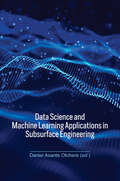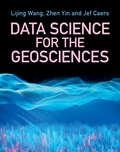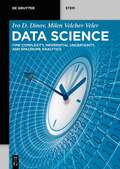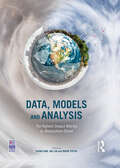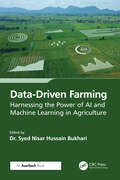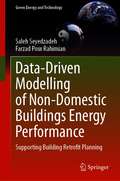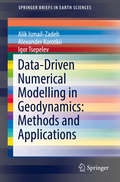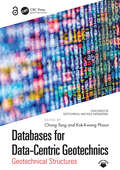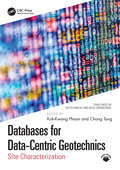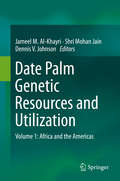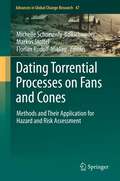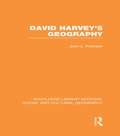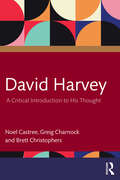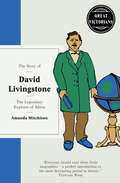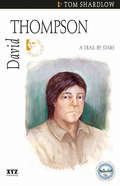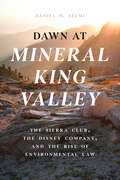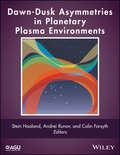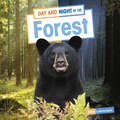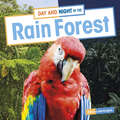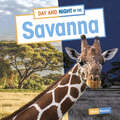- Table View
- List View
Data Modeling for the Sciences: Applications, Basics, Computations
by Steve Pressé Ioannis SgouralisWith the increasing prevalence of big data and sparse data, and rapidly growing data-centric approaches to scientific research, students must develop effective data analysis skills at an early stage of their academic careers. This detailed guide to data modeling in the sciences is ideal for students and researchers keen to develop their understanding of probabilistic data modeling beyond the basics of p-values and fitting residuals. The textbook begins with basic probabilistic concepts, models of dynamical systems and likelihoods are then presented to build the foundation for Bayesian inference, Monte Carlo samplers and filtering. Modeling paradigms are then seamlessly developed, including mixture models, regression models, hidden Markov models, state-space models and Kalman filtering, continuous time processes and uniformization. The text is self-contained and includes practical examples and numerous exercises. This would be an excellent resource for courses on data analysis within the natural sciences, or as a reference text for self-study.
Data Science and Machine Learning Applications in Subsurface Engineering
by Daniel Asante OtchereThis book covers unsupervised learning, supervised learning, clustering approaches, feature engineering, explainable AI and multioutput regression models for subsurface engineering problems. Processing voluminous and complex data sets are the primary focus of the field of machine learning (ML). ML aims to develop data-driven methods and computational algorithms that can learn to identify complex and non-linear patterns to understand and predict the relationships between variables by analysing extensive data. Although ML models provide the final output for predictions, several steps need to be performed to achieve accurate predictions. These steps, data pre-processing, feature selection, feature engineering and outlier removal, are all contained in this book. New models are also developed using existing ML architecture and learning theories to improve the performance of traditional ML models and handle small and big data without manual adjustments. This research-oriented book will help subsurface engineers, geophysicists, and geoscientists become familiar with data science and ML advances relevant to subsurface engineering. Additionally, it demonstrates the use of data-driven approaches for salt identification, seismic interpretation, estimating enhanced oil recovery factor, predicting pore fluid types, petrophysical property prediction, estimating pressure drop in pipelines, bubble point pressure prediction, enhancing drilling mud loss, smart well completion and synthetic well log predictions.
Data Science for the Geosciences
by Jef Caers Lijing Wang David Zhen YinData Science for the Geosciences provides students and instructors with the statistical and machine learning foundations to address Earth science questions using real-world case studies in natural hazards, climate change, environmental contamination and Earth resources. It focuses on techniques that address common characteristics of geoscientific data, including extremes, multivariate, compositional, geospatial and space-time methods. Step-by-step instructions are provided, enabling readers to easily follow the protocols for each method, solve their geoscientific problems and make interpretations. With an emphasis on intuitive reasoning throughout, students are encouraged to develop their understanding without the need for complex mathematics, making this the perfect text for those with limited mathematical or coding experience. Students can test their skills with homework exercises that focus on data scientific analysis, modeling, and prediction problems, and through the use of supplemental Python notebooks that can be applied to real datasets worldwide.
Data Science: Time Complexity, Inferential Uncertainty, And Spacekime Analytics (De Gruyter Stem Series)
by Ivo D. Dinov Milen Velchev VelevThe amount of new information is constantly increasing, faster than our ability to fully interpret and utilize it to improve human experiences. Addressing this asymmetry requires novel and revolutionary scientific methods and effective human and artificial intelligence interfaces. By lifting the concept of time from a positive real number to a 2D complex time (kime), this book uncovers a connection between artificial intelligence (AI), data science, and quantum mechanics. It proposes a new mathematical foundation for data science based on raising the 4D spacetime to a higher dimension where longitudinal data (e.g., time-series) are represented as manifolds (e.g., kime-surfaces). This new framework enables the development of innovative data science analytical methods for model-based and model-free scientific inference, derived computed phenotyping, and statistical forecasting. The book provides a transdisciplinary bridge and a pragmatic mechanism to translate quantum mechanical principles, such as particles and wavefunctions, into data science concepts, such as datum and inference-functions. It includes many open mathematical problems that still need to be solved, technological challenges that need to be tackled, and computational statistics algorithms that have to be fully developed and validated. Spacekime analytics provide mechanisms to effectively handle, process, and interpret large, heterogeneous, and continuously-tracked digital information from multiple sources. The authors propose computational methods, probability model-based techniques, and analytical strategies to estimate, approximate, or simulate the complex time phases (kime directions). This allows transforming time-varying data, such as time-series observations, into higher-dimensional manifolds representing complex-valued and kime-indexed surfaces (kime-surfaces). The book includes many illustrations of model-based and model-free spacekime analytic techniques applied to economic forecasting, identification of functional brain activation, and high-dimensional cohort phenotyping. Specific case-study examples include unsupervised clustering using the Michigan Consumer Sentiment Index (MCSI), model-based inference using functional magnetic resonance imaging (fMRI) data, and model-free inference using the UK Biobank data archive. The material includes mathematical, inferential, computational, and philosophical topics such as Heisenberg uncertainty principle and alternative approaches to large sample theory, where a few spacetime observations can be amplified by a series of derived, estimated, or simulated kime-phases. The authors extend Newton-Leibniz calculus of integration and differentiation to the spacekime manifold and discuss possible solutions to some of the "problems of time". The coverage also includes 5D spacekime formulations of classical 4D spacetime mathematical equations describing natural laws of physics, as well as, statistical articulation of spacekime analytics in a Bayesian inference framework. The steady increase of the volume and complexity of observed and recorded digital information drives the urgent need to develop novel data analytical strategies. Spacekime analytics represents one new data-analytic approach, which provides a mechanism to understand compound phenomena that are observed as multiplex longitudinal processes and computationally tracked by proxy measures. This book may be of interest to academic scholars, graduate students, postdoctoral fellows, artificial intelligence and machine learning engineers, biostatisticians, econometricians, and data analysts. Some of the material may also resonate with philosophers, futurists, astrophysicists, space industry technicians, biomedical researchers, health practitioners, and the general public.
Data, Models and Analysis: The Highest Impact Articles in 'Atmosphere-Ocean'
by Guoqi Han, Hai Lin and Douw SteynThis volume contains the ten most cited articles that have appeared in the journal Atmosphere-Ocean since 1995. These articles cover a wide range of topics in meteorology, climatology and oceanography. Modelling work is represented in five papers, covering global climate model development; a cumulus parameterization scheme for global climate models; development of a regional forecast modelling system and parameterization of peatland hydraulic processes for climate models. Data rehabilitation and compilation in order to support trend analysis work on comprehensive precipitation and temperature data sets is presented in four papers. Field studies are represented by a paper on the circumpolar lead system. While the modelling studies are global in their application and applicability, the data analysis and field study papers cover environments that are specifically, but not uniquely, Canadian. This book will be of interest to researchers, students and professionals in the various sub-fields of meteorology, oceanography and climate science.
Data-Driven Farming: Harnessing the Power of AI and Machine Learning in Agriculture
by Syed Nisar Hussain BukhariIn the dynamic realm of agriculture, artificial intelligence (AI) and machine learning (ML) emerge as catalysts for unprecedented transformation and growth. The emergence of big data, Internet of Things (IoT) sensors, and advanced analytics has opened up new possibilities for farmers to collect and analyze data in real-time, make informed decisions, and increase efficiency. AI and ML are key enablers of data-driven farming, allowing farmers to use algorithms and predictive models to gain insights into crop health, soil quality, weather patterns, and more. Agriculture is an industry that is deeply rooted in tradition, but the landscape is rapidly changing with the emergence of new technologies.Data-Driven Farming: Harnessing the Power of AI and Machine Learning in Agriculture is a comprehensive guide that explores how the latest advances in technology can help farmers make better decisions and maximize yields. It offers a detailed overview of the intersection of data, AI, and ML in agriculture and offers real-world examples and case studies that demonstrate how these tools can help farmers improve efficiency, reduce waste, and increase profitability. Exploring how AI and ML can be used to achieve sustainable and profitable farming practices, the book provides an introduction to the basics of data-driven farming, including an overview of the key concepts, tools, and technologies. It also discusses the challenges and opportunities facing farmers in today’s data-driven landscape. Covering such topics as crop monitoring, weather forecasting, pest management, and soil health management, the book focuses on analyzing data, predicting outcomes, and optimizing decision-making in a range of agricultural contexts.
Data-Driven Modelling of Non-Domestic Buildings Energy Performance: Supporting Building Retrofit Planning (Green Energy and Technology)
by Saleh Seyedzadeh Farzad Pour RahimianThis book outlines the data-driven modelling of building energy performance to support retrofit decision-making. It explains how to determine the appropriate machine learning (ML) model, explores the selection and expansion of a reasonable dataset and discusses the extraction of relevant features and maximisation of model accuracy. This book develops a framework for the quick selection of a ML model based on the data and application. It also proposes a method for optimising ML models for forecasting buildings energy loads by employing multi-objective optimisation with evolutionary algorithms. The book then develops an energy performance prediction model for non-domestic buildings using ML techniques, as well as utilising a case study to lay out the process of model development. Finally, the book outlines a framework to choose suitable artificial intelligence methods for modelling building energy performances. This book is of use to both academics and practising energy engineers, as it provides theoretical and practical advice relating to data-driven modelling for energy retrofitting of non-domestic buildings.
Data-Driven Numerical Modelling in Geodynamics: Methods and Applications (SpringerBriefs in Earth Sciences)
by Alik Ismail-Zadeh Alexander Korotkii Igor TsepelevThis book describes the methods and numerical approaches for data assimilation in geodynamical models and presents several applications of the described methodology in relevant case studies. The book starts with a brief overview of the basic principles in data-driven geodynamic modelling, inverse problems, and data assimilation methods, which is then followed by methodological chapters on backward advection, variational (or adjoint), and quasi-reversibility methods. The chapters are accompanied by case studies presenting the applicability of the methods for solving geodynamic problems; namely, mantle plume evolution; lithosphere dynamics in and beneath two distinct geological domains - the south-eastern Carpathian Mountains and the Japanese Islands; salt diapirism in sedimentary basins; and volcanic lava flow. Applications of data-driven modelling are of interest to the industry and to experts dealing with geohazards and risk mitigation. Explanation of the sedimentary basin evolution complicated by deformations due to salt tectonics can help in oil and gas exploration; better understanding of the stress-strain evolution in the past and stress localization in the present can provide an insight into large earthquake preparation processes; volcanic lava flow assessments can advise on risk mitigation in the populated areas. The book is an essential tool for advanced courses on data assimilation and numerical modelling in geodynamics.
Databases for Data-Centric Geotechnics: Geotechnical Structures (Challenges in Geotechnical and Rock Engineering)
by Chong Tang and Kok-Kwang PhoonDatabases for Data-Centric Geotechnics forms a definitive reference and guide to databases in geotechnical and rock engineering, to enhance decision-making in geotechnical practice using data-driven methods. This second volume pertains to geotechnical structures. The opening chapter presents a substantial survey of performance databases and the effectiveness of our prediction models in matching the field measurements in these databases, based on (1) full-scale field tests, (2) 39 prediction exercises organized as a part of international conferences, and (3) comparison between numerical analyses and in-situ or field measurements conducted by the French LCPC. The focus is on the evaluation of the statistical degree of confidence in predicting various of quantities of interest such as capacity and deformation. The following 18 chapters then present databases on the performance of shallow foundations, spudcan foundations, deep foundations, anchors and pipelines, retaining systems and excavations, and landslides. The databases were compiled from studies undertaken in many countries such as Australia, Belgium, Bolivia, Brazil, Canada, China, Egypt, France, Germany, Hungary, Iran, Ireland, Japan, Kenya, Malaysia, Netherlands, Norway, Poland, Portugal, South Africa, the United Kingdom and the United States.This volume on geotechnical structures is a companion to the volume on site characterization. Databases for Data-Centric Geotechnics represents the most diverse and comprehensive assembly of database research in a single publication (consisting of two volumes) to date. It follows from Model Uncertainties for Foundation Design, also published by CRC Press, and suits specialist geotechnical engineers, researchers and graduate students.Chapter 10 of this book is freely available as a downloadable Open Access PDF at http://www.taylorfrancis.com under a Creative Commons [Attribution (CC BY)] 4.0 license.
Databases for Data-Centric Geotechnics: Site Characterization (Challenges in Geotechnical and Rock Engineering)
by Kok-Kwang Phoon and Chong TangDatabases for Data-Centric Geotechnics forms a definitive reference and guide to databases in geotechnical and rock engineering, to enhance decision-making in geotechnical practice using data-driven methods. This first volume pertains to site characterization. The opening chapter presents an in-depth analysis of site data attributes, including the establishment of a new taxonomy of site data under “4S” (site generalizations, spatial features, sampling characteristics, and smart data) to provide a novel agenda for data-driven site characterization. Type 3 machine learning methods (disruptive value) are possible as sensors become more pervasive and more intelligent. A comprehensive overview of site characterization information is also presented with a focus on its availability, coverage, value to decision making, and challenges. The remaining 13 chapters cover databases of soil and rock properties and the application of these databases to rock socket behavior, rock classification, settlement on soft marine clays, permeability of fine-grained soils, and liquefaction among others. The databases were compiled from studies undertaken in many countries including Austria, Australia, Brazil, Canada, China, France, Finland, Germany, India, Iran, Japan, Korea, Malaysia, Mexico, New Zealand, Norway, Singapore, Sweden, Thailand, the United Kingdom, and the United States.This volume on site characterization is a companion to the volume on geotechnical structures. Databases for Data-Centric Geotechnics represents the most diverse and comprehensive assembly of database research in a single publication (consisting of two volumes) to date. It follows from Model Uncertainties for Foundation Design, also published by CRC Press, and suits specialist geotechnical engineers, researchers and graduate students.
Date Palm Genetic Resources and Utilization: Volume 1: Africa and the Americas
by Shri Mohan Jain Jameel M. Al-Khayri Dennis V. JohnsonThis important 2-volume reference book is the first comprehensive resource reflecting the current global status and prospects of date palm cultivation by country. This volume covers Asia and Europe. The Asian countries included are: Iran, Saudi Arabia, Iraq, Pakistan, Oman, Yemen, Israel, Kuwait, Qatar, Bahrain, Syria, Palestine and India. Europe is represented by Spain. Topics discussed are: cultivation practices; genetic resources and breeding; conservation and germplasm banks; cultivar classification and identification based on morphological and molecular markers; micropropagation and progress toward scale-up production; and advances in dates processing and marketing. Chapters are supported by tables and color photographs. Appendixes summarize traits and distribution of major cultivars, commercial resources of offshoots and in vitro plants; and institutions and scientific societies concerned with date palm.
Dating Torrential Processes on Fans and Cones: Methods and Their Application for Hazard and Risk Assessment (Advances in Global Change Research #47)
by Florian Rudolf-Miklau Markus Stoffel Michelle Schneuwly-BollschweilerThis book provides a detailed overview on methods used for the dating of past torrential activity on fans and cones and fosters the discussion on the impact of past and potential future climate change on torrential processes. The book has a clear focus on the practical applications of these methods, complemented by case studies. The limits of each dating method in case of excessive natural and human interventions on fans and cones are shown.
David Attenborough Lines to Live By: Embrace the wonder of your world
by Pop Press'I am hopeful for the future, because although nature is in crisis, now is the time for action.'For 70 years, David Attenborough's soothing voice has brought the magic of nature to our TV screens, teaching millions around the world about beautiful animals and the climate crisis that endangers them.David Attenborough Lines to Live By is a celebration of Sir David's impact on the natural world and will inspire everyone to appreciate and protect the fragile world around us.
David Harvey's Geography: Social And Cultural Geography: David Harvey's Geography (Routledge Library Editions: Social and Cultural Geography)
by John L. PatersonThe emphasis of this book is to explore two major philosophical influences in contemporary human geography, namely logical positivism and Marxism, and to explore the relationships between philosophy, methodology and geographical research. Rather than being a biography of David Harvey, the book contributes to the understanding of one of the most innovative and iconoclastic scholars in contemporary Anglo-American human geography.
David Harvey: A Critical Introduction to His Thought
by Brett Christophers Noel Castree Greig CharnockDavid Harvey is among the most influential Marxist thinkers of the last half century. This book offers a lucid and authoritative introduction to his work, with a structure designed to reflect the enduring topics and insights that serve to unify Harvey’s writings over a long period of time. Harvey’s writings have exerted huge influence within the social sciences and the humanities. In addition, his work now commands a global readership among Left political activists and those interested in current world affairs. Harvey’s central preoccupation is capitalism and the impacts of its growth-obsessed, contradictory dynamics. His name is synonymous with key analytical concepts like ‘the spatial fix’ and ‘accumulation by dispossession’. This critical introduction to his thought is an essential companion for both new and more experienced readers. The critique of capitalism is one of the most important undertakings of our time, and Harvey’s work offers powerful tools to help us see why a ‘softer’ capitalism is insufficient and a post-capitalist future is necessary. This book is an important resource for scholars and graduate students in geography, politics and many other disciplines across the social sciences and humanities.
David Livingstone: The Legendary Explorer Of Africa (Great Victorians)
by Amanda MitchisonBorn a poor Glasgow cotton-mill worker, David grew up to become a great explorer and hero of his time.This is his incredible story. The tough man of Victorian Britain would stop at nothing in his determination to be the first white man to explore Africa, even if it meant dragging his wife and children along with him.He trekked hundreds of miles through dangerous territory, braving terrible illness and pain, and was attacked by cannibals, rampaging lions and killer ants…Short Books is re-releasing some of its finest writing as a newly designed series of six children’s biographies called The Great Victorians. These are entertaining and engaging stories of some of history’s most fascinating characters. They tell history in a novelistic, engaging way, a halfway house between storybooks and traditional history. There is abundant humour and drama too.With beautifully designed covers these books will catch the eyes of parents as well as children. Also published in a highly collectable set.
David Suzuki's Green Guide
by David Suzuki David R. BoydEveryone knows that the planet is in trouble, but is there a solution? This timely book identifies the most effective ways individuals can be more green in four key areas: home, travel, food, and consumerism. It also describes how citizens can ensure that governments take the actions necessary to make sustainable lifestyles the norm instead of the exception. Environmental lawyer David Boyd and celebrated ecologist David Suzuki provide vital tips for choosing a home, creating a healthy indoor environment, and decreasing energy and water use - and utility bills. They discuss what readers can do to drive and fly less, profile the most environmentally friendly transportation choices, and explain how to purchase carbon credits, among other suggestions. In addition, they offer simple changes individuals can make in their diet to eat fresher, tastier, healthier food. Included too is invaluable advice about how to buy fewer things and avoid toxic consumer products.
David Thompson
by Tom ShardlowAcross North America in 2007-2009, communities will celebrate the David Thompson Bicentennials. For 34 years the great explorer, surveyor, and fur trader travelled across the continent, finding and mapping the routes between the St. Lawrence and the Pacific. Trusting the stars and his sextant, he surveyed a continental area so vast it remains a mapping achievement unequalled in human history. This is the story of David Thompsons epic journey his trail by stars.
Dawn at Mineral King Valley: The Sierra Club, the Disney Company, and the Rise of Environmental Law
by Daniel P. SelmiThe story behind the historic Mineral King Valley case, which reveals how the Sierra Club battled Disney’s ski resort development and launched a new environmental era in America. In our current age of climate change–induced panic, it’s hard to imagine a time when private groups were not actively enforcing environmental protection laws in the courts. It wasn’t until 1972, however, that a David and Goliath–esque Supreme Court showdown involving the Sierra Club and Disney set a revolutionary legal precedent for the era of environmental activism we live in today. Set against the backdrop of the environmental movement that swept the country in the late 1960s and early 1970s, Dawn at Mineral King Valley tells the surprising story of how the US Forest Service, the Disney company, and the Sierra Club each struggled to adapt to the new, rapidly changing political landscape of environmental consciousness in postwar America. Proposed in 1965 and approved by the federal government in 1969, Disney’s vast development plan would have irreversibly altered the practically untouched Mineral King Valley, a magnificently beautiful alpine area in the Sierra Nevada mountains. At first, the plan met with unanimous approval from elected officials, government administrators, and the press—it seemed inevitable that this expanse of wild natural land would be radically changed and turned over to a private corporation. Then the scrappy Sierra Club forcefully pushed back with a lawsuit that ultimately propelled the modern environmental era by allowing interest groups to bring litigation against environmentally destructive projects. An expert on environmental law and appellate advocacy, Daniel P. Selmi uses his authoritative narrative voice to recount the complete history of this revolutionary legal battle and the ramifications that continue today, almost 50 years later.
Dawn-Dusk Asymmetries in Planetary Plasma Environments
by Stein Haaland Andrei Runov Colin ForsythDawnDusk Asymmetries in Planetary Plasma Environments Dawn-dusk asymmetries are ubiquitous features of the plasma environment of many of the planets in our solar system. They occur when a particular process or feature is more pronounced at one side of a planet than the other. For example, recent observations indicate that Earth's magnetopause is thicker at dawn than at dusk. Likewise, auroral breakups at Earth are more likely to occur in the pre-midnight than post-midnight sectors. Increasing availability of remotely sensed and in situ measurements of planetary ionospheres, magnetospheres and their interfaces to the solar wind have revealed significant and persistent dawn-dusk asymmetries. As yet there is no consensus regarding the source of many of these asymmetries, nor the physical mechanisms by which they are produced and maintained. Volume highlights include: A comprehensive and updated overview of current knowledge about dawn-dusk asymmetries in the plasma environments of planets in our solar system and the mechanisms behind them Valuable contributions from internationally recognized experts, covering both observations, simulations and theories discussing all important aspects of dawn-dusk asymmetries Space weather effects are caused by processes in space, mainly the magnetotail, and can be highly localized on ground. Knowing where the source, i.e., where dawn-dusk location is will allow for a better prediction of where the effects on ground will be most pronounced Covering both observational and theoretical aspects of dawn dusk asymmetries, Dawn-Dusk Asymmetries in Planetary Plasma Environments will be a valuable resource for academic researchers in space physics, planetary science, astrophysics, physics, geophysics and earth science.
Day and Night (Cycles of Nature)
by Jaclyn JaycoxThe sun shines bright during the day, but why can't you see it at night? Follow the patterns of the sun and Earth to learn what causes day and night.
Day and Night in the Desert (Habitat Days and Nights)
by Ellen LabrecqueSpend a day and night in the desert! Learn about this dry habitat through the unique animals that call it home. Stand with meerkats during a watchful hunt for insects. Spot a jackrabbit taking a shaded midday nap. Join a desert tortoise as it dines on colorful cactus fruit. After dark, follow a snake as it slithers in cool, moonlit sand. What will tomorrow bring in the desert?
Day and Night in the Forest (Habitat Days and Nights)
by Ellen LabrecqueSpend a day and night in the forest! Learn about this wooded habitat through the fascinating animals that call it home. Leap from tree to tree with a squirrel searching for breakfast. Pounce with a fox on the forest floor. Soar with a red-tailed hawk as the sun sets. After dark, build a dam with a beaver. What will tomorrow bring in the forest?
Day and Night in the Rain Forest (Habitat Days and Nights)
by Ellen LabrecqueSpend a day and night in the rain forest! Learn about this lush habitat through the diverse animals that call it home. Start the morning suspended high in the canopy with a colorful toucan. Curl around a branch and bask in afternoon sun with an emerald boa. At sunset, pace the forest floor for prey alongside a sleek jaguar. After dark, spy a nocturnal sloth slowly wake after a full day of slumber. What will tomorrow bring in the rain forest?
Day and Night in the Savanna (Habitat Days and Nights)
by Mary BooneSpend a day and night in the savanna! Learn about this grassy habitat through the interesting animals that call it home. Nibble a breakfast of sky-high leaves with a giraffe. Then construct towering mounds with termites. At sunset, shriek and prowl for prey with a pack of hyenas. After dark, go on a high-speed hunt with a cheetah. What will tomorrow bring in the savanna?

